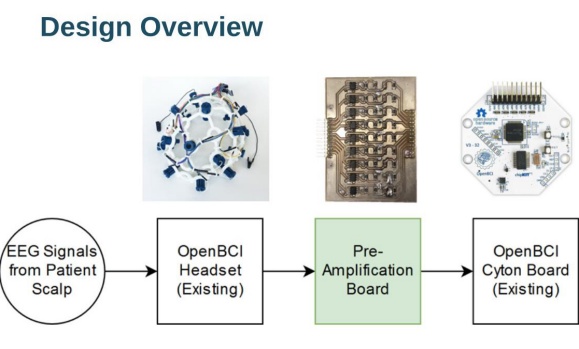News
» Go to news mainEngineering a Better EEG

Last December, ôÕѿǨû§ãs Electrical and Computer Engineering Department (ECED) saw six groups of students complete their Engineering degrees, including the completion of their Capstone projects. ECED is the only engineering department at Dal with a regular cohort of students who finish in December.
Graduates of the Electrical and Computer Engineering Department can look forward to careers in the areas of power systems, communication systems, control systems, computers, environmental sensing, medical/health monitoring, radios, robots, and photonics. Some of this interesting and exciting work starts with their Capstone project.
Topics for this group included:
- Improved Gain for a Brain-Computer Interface
- High Current, Power Distribution And Measurement Bus
- Sanitary Specific Gravity Sensor
- Unifiller Machine Cycle Counter
- Machine Learning in Mobile Security Applications
While many Capstone Projects include industry collaboration, we also have student teams working with faculty and researchers at ôÕѿǨû§. Students David Hoar, Patrick MacIntyre, Daniel MacRae, and Brady Walsh worked in collaboration with Dr. Tim Bardouille of ôÕѿǨû§ãs Departments of Physics and Atmospheric Science on their project ãImproved Gain for a Brain-Computer Interface.ã The purpose of this project was to develop a new acquisition board to improve upon the equipment currently used for Electroencephalograms (EEGs).
"Working on the project for Dr. Bardouille was an amazing opportunity to apply our electrical engineering skills to benefit his neurological research," says Patrick MacIntyre, "We got great feedback throughout the project which helped shape our final design." ô
The Biosignal Lab
In addition to research work pertaining to brain activity, an EEG is used to monitor brain activity to diagnose seizure and sleep disorders. Dr. Bardouille conducts Neuroimaging Research at ôÕѿǨû§ãs Biosignal Lab. The Lab uses non-invasive advanced imaging technologies to measure and study signals that are generated by activity in the brain.
Dr. Bardouille and his team develop new software and hardware for brain imaging, and new ways to analyze brain imaging data. This interdisciplinary research combines physics, mathematics, computer science, psychology, and neuroscience. Dr. Bardouille began this research in 2000 and has been recording brain activity at ôÕѿǨû§ in the Biosignal Lab since the fall of 2017.
The current acquisition board used by the Biosignal lab is an open source board called the OpenBCI Cyton board. Because itãs open source, itãs easier for other researchers to use and modify it. Along with the board, the team uses a headset with a series of electrodes that attach to the scalp. The acquisition board processes the brain signals from the headset and transmits them to a computer. Part of the process involves filtering out noise from the electrical impulses measured to obtain the desired signal.
Student team work
The student team focused their work on developing a pre-amplification board that could easily be added to the existing system. The goal was to improve the signal to noise ratio (SNR) of the current system, while maintaining signal bandwidth. An amplified signal would allow for detection of smaller variations in brain activity.
The students developed a prototype that connects to the existing headset and Cyton board system, maintains the signal bandwidth, improves the system gain, and maintains the signal to noise ratio. Their prototype requires more power than the current system, but that can easily be managed with a higher capacity battery.
Moving forward
The next step is to test the amplified board with human participants (rather than bench equipment) to measure the impact on the quality of the recorded brain waves.The team has several recommendations for future improvements for their prototype, in both the design and production. The students built their prototype themselves, with the assistance of department technicians; however, future iterations could be made smaller and more efficient with outside assistance. The team engaged the OpenBCI online discussion forum, including providing their schematics, in case others want to use this technology for further research.
Recent News
- Engineering Young Alumni Reception
- Students scale new heights with Toronto tower pitch
- ôÕѿǨû§ Students Develop Automation Tool for Irving Shipbuilding
- 2025 Capstone Poster Expo
- ôÕѿǨû§ Engineering Students Lead the 2025 Canadian Engineering Competition
- ãA painless flash of lightã: Biomedical Engineering student wins 3 Minute Thesis
- Sparking a Passion for Indigenous Engagement in Engineering
- 2025 Engineering Student Experience Showcase
